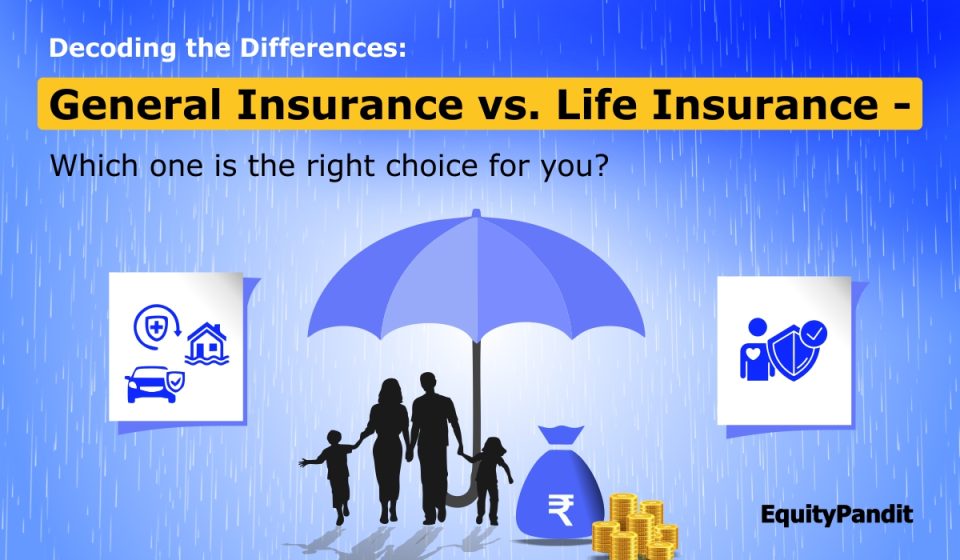Life and General Insurance Meaning
Feeling safe and secure in every aspect of our lives is a universal desire. When you think about insurance, you think about protection. Different insurance plans are designed to meet your diverse needs, whether it’s safeguarding your life, health, loved ones, or financial future. Insurance is like a safety net, providing comprehensive protection against life’s risks.
Insurance is an agreement between the buyer and the insurance company. The buyer pays a set amount, gaining peace of mind and financial security in return. Insurance serves multiple purposes, whether to build wealth, a retirement plan, or provide a safety net in the face of unexpected events.
Insurance comes in two main categories: life insurance and general insurance. Life insurance covers the risks associated with an individual’s life, whereas general insurance covers health risks and protects tangible assets like homes and cars. It’s all about providing much-needed protection and support for whatever life throws at us.
What is Life Insurance and its types?
Life insurance is a legal agreement between an individual (the policyholder) and an insurance company. In this contract, the insurance company guarantees that a designated sum of money will be provided to the designated beneficiaries in the event of the policyholder’s death. This payment is made in exchange for the policyholder paying a regular premium to the insurance company. Sometimes, the payout may also occur after a predetermined period if the policyholder is still alive.
There are six main types of life insurance policies:
1. Term insurance plan: Purchased for a fixed period without maturity benefits.
2. Endowment policy: Similar to term insurance but with a lump sum payout if the policyholder survives until maturity.
3. Unit Linked Insurance Plan: Offers the opportunity to build wealth and life security.
4. Money Back Policy: Like the endowment policy, survival benefits are paid out during the policy term.
5. Whole Life Policy: This policy provides coverage for the insured’s entire life and offers survival benefits and withdrawal options.
6. Annuity/Pension Plan: Premiums are accumulated and distributed as income through the annuity or lump sum payments.
What is general insurance and its types?
General Insurance is a type of Insurance that covers financial losses resulting from the Loss or destruction of the insured asset. It covers non-life risks and involves a policy or agreement between the policyholder and the insurer.
The policyholder, who has a financial interest in the covered asset, pays the premium, and the insurer protects the insured from financial liability in case of Loss. Insurance coverage is compulsory for most categories, such as motor insurance, under the Motor Vehicles Act 1988.
General insurance plans provide compensation against losses and offer tax benefits; for example, medical insurance premiums provide tax benefits under Section 80D of the Income Tax Act.
General Insurance is broadly classified into the following five types:
1. Health Insurance: Covers medical expenses for individuals, families, and groups.
2. Motor Insurance: Covers vehicles against damage and third-party liabilities.
3. Travel Insurance: Provides financial protection for domestic or international travel.
4. Property Insurance: Protects buildings and contents against damage and injury.
5. Commercial Insurance: Covers commercial businesses against financial and liability risks.
Differences between Life and General Insurance
| Serial No. | Particulars | Life Insurance | General Insurance |
| 1) | Meaning | A life insurance policy provides coverage for the insured person’s life risk. | On the other hand, general insurance covers a range of non-life risks, such as property, health, travel, and auto insurance. |
| 2) | Duration | Life insurance is a crucial long-term financial plan that provides coverage for a specified duration, typically 15 to 20 years or even a lifetime, depending on the contract terms. | General insurance policies are effective for a short time and require regular renewal at regular intervals. |
| 3) | Premium | In Life Insurance, the policyholder is required to pay the predefined premium amount at regular intervals, such as monthly, quarterly, or yearly. | In General Insurance, the policyholder pays a lump sum amount at the time of purchase or renewal. Travel insurance may vary, as it is required only when a specific trip needs to be insured. |
| 4) | Insurable Interest | When purchasing a life insurance policy, the policyholder must be present at the time of the plan purchase. | Similarly, for general insurance, the policyholder needs to be present not only during the purchase of the policy but also when any payouts are being processed. |
| 5) | Policy Value | In Life Insurance, the policyholder can choose the sum assured based on the beneficiary’s financial condition and anticipated future requirements. | On the other hand, the policy’s value in General Insurance is affected by and decided based on the worth of the insured asset. |
| 6) | Insurance Claim | In life insurance, the beneficiary receives the sum assured if the policyholder passes away. When the policy matures, the policyholder may also receive the sum assured. With money-back or endowment plans, the policyholder also receives interest from investments. | In general Insurance, according to the contract’s coverage, the policyholder gets assured benefits if an unfortunate event occurs, such as damage or Loss of an insured asset. |
| 7) | Form and Term of Contract | Life insurance is considered to be a long-term investment | General Insurance is considered to be a short-term form of indemnity contract. |
| 8) | Taxability in India | The proceeds from insurance policies (excluding ULIP plans) taken out on or after April 1, 2023, will be subject to taxation if the total yearly premium exceeds Rs. 5 Lakhs. Further, GST at 18% is paid on the premium paid. | In General Insurance, Goods and Services Tax is to be paid at 18%. Further, on receiving the lumpsum amount after the maturity of the contract, it’s taxable per the income tax bracket of an individual or an entity. |
| 9) | Tax Benefits in India | Under section 80C of the Income Tax Act of 1961, you can receive a deduction of Rs. 1.5 Lacs from your net taxable income on life insurance premiums paid for yourself, your children, or your partner. | The amount you spend on Health Insurance premiums is eligible for tax deduction under Section 80D of the Income Tax Act, 1961. In a financial year, you can claim a maximum deduction of Rs 25,000 for yourself, your spouse, and your children. If you are a senior citizen (above 60 years), this limit can be extended to Rs 30,000. If you pay Health Insurance premiums for your parents, you can also include them to avail tax benefits. |
Frequently Asked Questions (FAQs)
Is Marine Insurance a part of General Insurance in India?
Yes. Marine Insurance is governed by the Marine Insurance Act of 1963, and regulated by the Insurance Regulatory and Development Authority of India (IRDAI).
Which Act regulates the Life Insurance segment in India?
The Life Insurance Corporation Act, of 1956, governs the Life Insurance Rules in India which are supervised by IRDAI – Insurance Regulatory Development Authority of India.
What are the top 5 Insurance companies in India in 2024 by market capitalisation?
Life Insurance Corporation of India (LIC), Bajaj Finserv Limited, SBI Life insurance company ltd., HDFC Life insurance company limited, and ICICI Prudential Life Insurance company limited.
When should you opt for a Health Insurance Plan?
Health Insurance Plans offer financial protection for medical emergencies. It’s a good idea to invest in a plan when you’ve secured a steady job or business to ensure timely premium payments and immediate coverage.
What is the e-Insurance rule, effective from April 1, 2024 in India?
The new e-insurance rule in India, implemented on April 1st, 2024, mandates that all new insurance policies be issued electronically. They are kept similar to shares, held in a demat account.
What is the rule regarding e-Insurance Account (eIA)?
You will need an eIA to hold these electronic policies. Four repositories manage eIAs: CAMS Repository, Karvy, NSDL Database Management (NDML), and Central Insurance Repository of India.
Do you have the option to convert your old offline Insurance policies into an online form?
You may keep your existing physical or offline policies as they are. However, you can also convert them to an e-policy if you wish.
Discover Unicorn Signals, the ultimate Super App for the Indian Stock Market, brought to you by EquityPandit. With over 103 powerful tools, it’s designed to enhance your trading and investing experience tenfold. Accessible on Android, iPhone, and the web, this AI-powered application is your gateway to exploring the Indian Stock Market and boosting your wealth.
Disclaimer: Investing in the equity market in India is subject to risks, i.e., the market fluctuates. This article is purely for educational purposes. The views expressed and data provided here are by Equitypandit’s team. Kindly do not completely depend on the information provided, as the risk appetite differs from individual to individual, and various other factors in the market determine the factors to invest in.
 Live
Live

